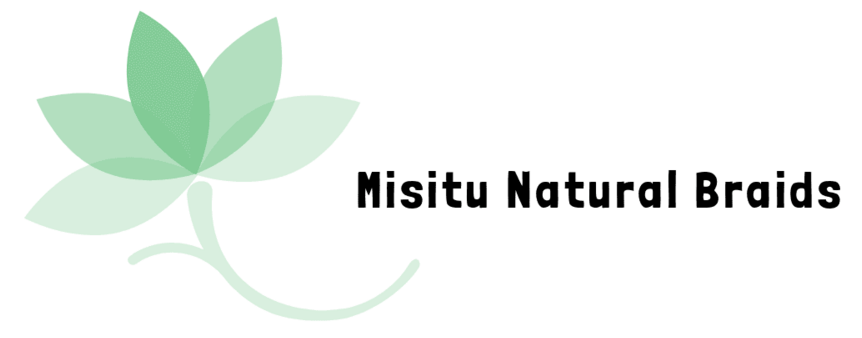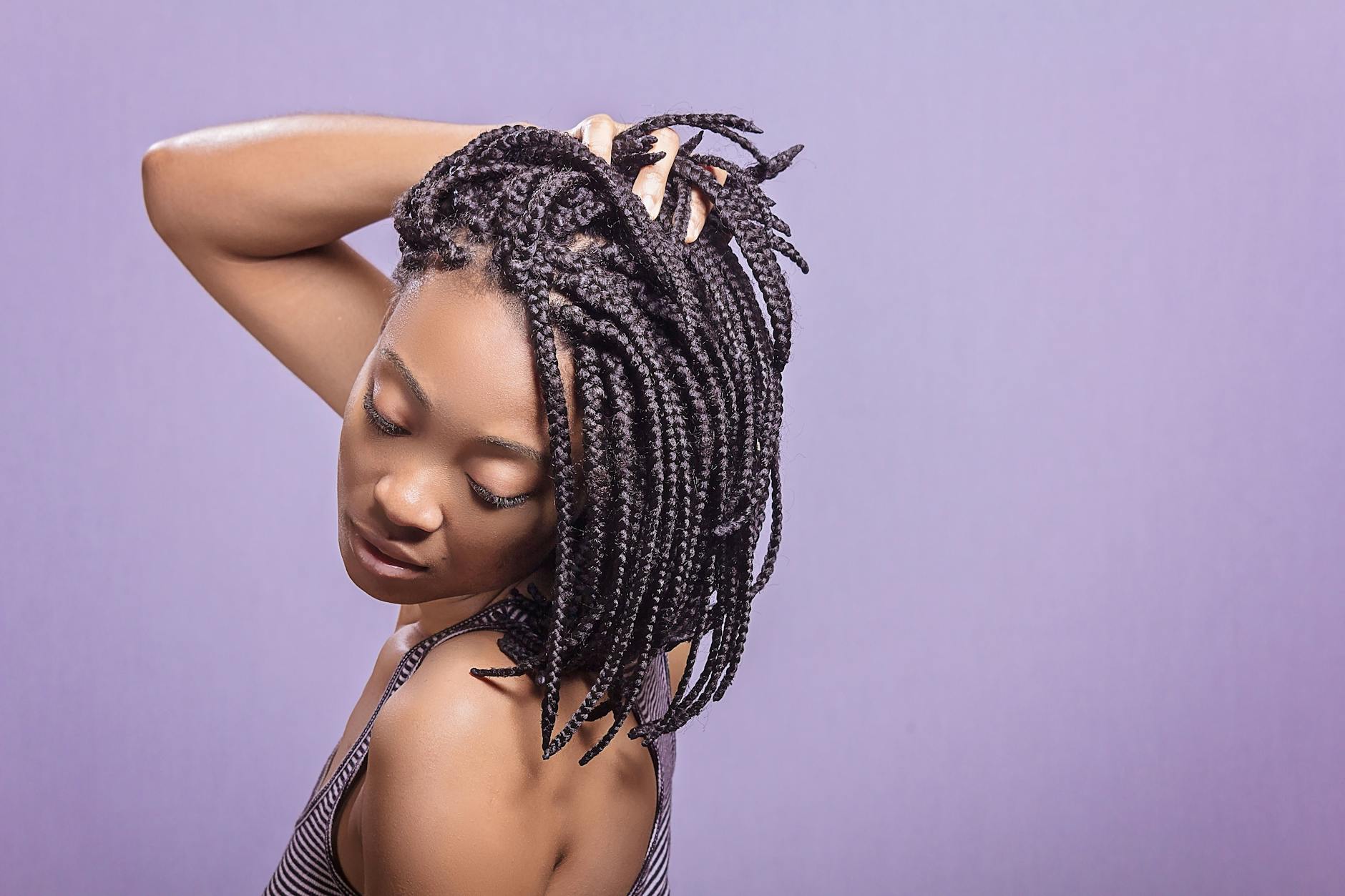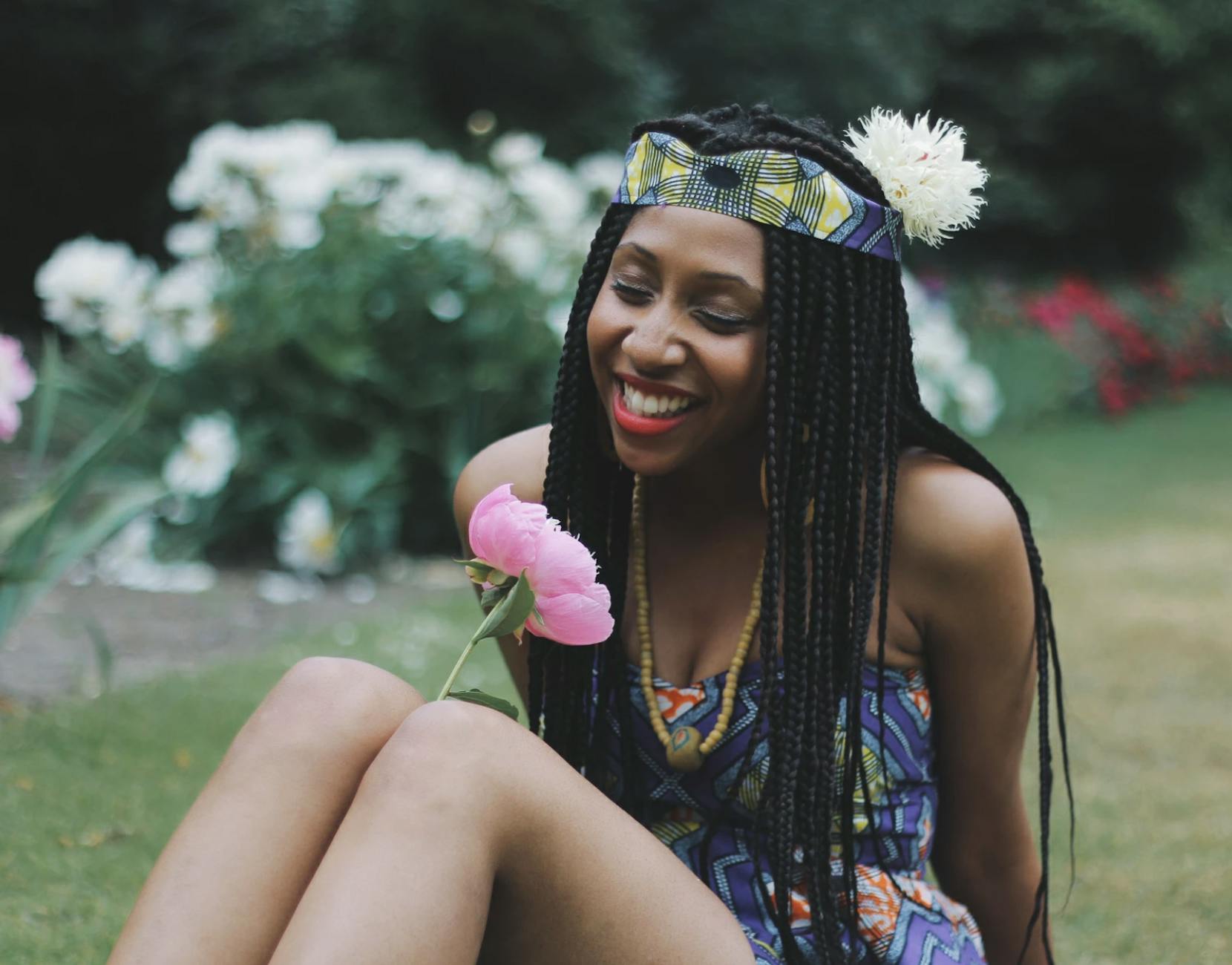Quality & Durability
When it comes to switching from synthetic to plant-based braiding hair, one of the biggest concerns is quality and durability. After all, no one wants to invest in a new hair product only to have it fall apart in a few days! If you’re wondering whether plant-based braiding hair can hold up to your hairstyling needs, let’s dive into the details.
How Does Plant-Based Braiding Hair Compare to Synthetic Braiding Hair?
The biggest difference between plant-based braiding hair and synthetic options is texture. If you’re used to traditional synthetic hair, which can sometimes feel rough or plasticky, plant-based hair will be a pleasant surprise. It has a much softer, more natural feel, making it more comfortable against your scalp. You won’t have to deal with the stiffness or unnatural shine that synthetic hair often has. Misitu’s plant based braiding hair feels like natural human hair. It’s also very easy to braid with as it easily glides through your hands and it has a good grip. They are all pre-stretched hair which is the best for braiding hair.
How Long Does the Hair Last?
If you’re investing in plant-based braiding hair, you probably want to know how long it will stay looking fresh. The good news? With proper care, it can last just as long as synthetic hair—anywhere from six to eight weeks, depending on how well you maintain it.
The hair is free of the harsh chemicals found in synthetic options, it may require a little extra love to keep it looking great. You’ll want to avoid tight hairstyles that pull your hair and keep your braids moisturized. If you’re someone who likes to keep braids in for months at a time, Misitu’s plant-based hair options will be a great fit for you.
Does Plant-Based Braiding Hair Frizz More Than Synthetic Hair?
One of the most common concerns about plant-based braiding hair is whether it frizzes more than synthetic alternatives. The short answer? It depends on how you care for it. Because the hair is made from natural fibers, it can be prone to frizz if not maintained properly.
Unlike synthetic hair, which tends to have a smooth, plasticky coating that prevents frizz, plant-based options behave more like natural hair. That means humidity, frequent styling, and rubbing against clothing can cause some flyaways. But don’t worry! Using a lightweight styling mousse and wrapping your braids at night with a satin scarf can help reduce frizz. With the right care, the hairstyle can stay sleek for weeks.
Does the Hair Tangle or Shed Easily?
Tangles and shedding are another concern for those making the switch to plant-based braiding hair. Applying a generous amount of mousse or a bit of lightweight oil like coconut, jojoba or olive oil can go a long way in keeping your braids smooth. Also, when taking down your braids, be extra gentle to avoid unnecessary shedding especially if you’re planning on reusing them. Misitu’s plant-based hair is designed specifically to avoid tangling so you won’t have to worry about any tangles or taking a long time to detangle the hair before braiding. The hair is pre-combed and ready to go.
Can the Hair Be Reused for Multiple Installations?
If you love getting the most out of your hair investments, you’ll be happy to know that plant-based braiding hair can be reused for up to 3 times! Unlike synthetic hair, which can become brittle and matted after one use, plant-based hair holds up better over time, especially if properly maintained.
To reuse the hair carefully remove it, detangle it with a gentle brush, and wash it with a mild shampoo. Let it air dry completely before storing it for your next installation. Please store the hair in a breathable drawstring bag for it to last longer. Some users report getting up to four uses out of a single set of braiding hair, making it a budget-friendly and eco-conscious choice.
Styling & Maintenance
So, you’ve made the switch to plant-based braiding hair—great choice! But now you might be wondering, how do I take care of it? From sealing the ends to washing and styling, plant-based hair has its own unique needs. The good news? With the right routine, it can stay looking flawless for weeks. Let’s break it all down.
How Do You Seal the Ends of Plant-Based Braiding Hair?
Sealing the ends of plant-based braiding hair is a little different from synthetic hair, and it might take some experimenting to find what works best for you. Unlike synthetic fibers that easily melt together with hot water, plant-based hair is made from natural fibers, which react differently to heat.
Some people find that dipping the ends in hot water helps, but it may not always create a strong hold. If your braids keep unraveling, try rubber bands as alternatives. You can also use a small amount of natural braid gel or mousse to give the ends extra hold. If you’re after long-lasting braids, sealing is key—so don’t skip this step!
Is the Hair Heat-Resistant for Styling Purposes?
Plant-based braiding hair doesn’t always hold up to high heat the way synthetic or human hair does. Since it’s made from natural fibers, direct heat can weaken the structure of the hair, making it more prone to frizz and breakage. If you love curling or straightening your braids, be extra careful. If you plan on using heat use medium to low heat.
Instead of heat styling, try using overnight heatless methods like perm rods, flexi rods, or braid-outs to achieve beautiful waves or curls. These techniques give you the versatility of styling without causing unnecessary damage. And if you absolutely must use heat, try dipping the perm rods, flexi rods or braid- outs in hot water to get longer lasting bouncy curls!
Can Plant-Based Braiding Hair Be Washed?
Yes, you can wash plant-based braiding hair—but like with any braided style, you’ll want to be gentle to avoid frizz and unraveling. The best way to wash it is by focusing on your scalp rather than the braids themselves.
If your braids start feeling dry a few days after a wash, follow up with a hair spraying your scalp with just water and then add a few drops of lightweight oil to restore moisture. Just remember: less is more! Applying too much product can make the hair feel heavy and lead to buildup over time.
Does the Hair Require Special Maintenance Routines?
Compared to synthetic hair, plant-based braiding hair does require a little extra love, but it’s nothing too complicated! Because it’s made from natural materials, it can dry out faster than synthetic hair, so keeping it moisturized is key.
Here’s a simple routine to keep your braids looking fresh:
- Wrap your hair at night with a satin scarf or bonnet to prevent frizz and tangling or if you don’t like wearing bonnets, tie your hair up in a ponytail with scrunchies and sleep on a satin or silk pillow.
- Spritz your braids with water every few days to keep them moisturized.
- Use a lightweight scalp oil to avoid dryness and irritation.
With a little care, your braids will stay sleek and beautiful for weeks! Check out this article for more tips on how to take care and maintain your braids.
Can I Swim or Exercise with this Hairstyle?
Yes, you absolutely can—but with a few precautions. Unlike synthetic hair, which can sometimes become stiff after getting wet, plant-based braiding hair absorbs water more easily, which can make it feel heavier when soaked. If you’re planning to swim, wearing a swim cap can help protect your braids from chlorine or saltwater.
After a workout, sweat can build up on your scalp, so it’s a good idea to refresh with washing your braids every two to three weeks. If you’re washing your hair, be sure to let it air dry completely to prevent mildew or an unpleasant smell. With the right post-workout care, you can enjoy an active lifestyle without worrying about your braids.
Comfort & Health Benefits
If you’ve ever had to take down your braids because of scalp irritation, you know the struggle of dealing with uncomfortable hair extensions. Traditional synthetic braiding hair often contains chemicals that can trigger itching, burning, and even allergic reactions. But with plant-based braiding hair, many of those worries disappear! Let’s dive into how this eco-friendly alternative can keep both your scalp and hair happy.
Is Plant-Based Braiding Hair Really Hypoallergenic?
One of the biggest reasons people switch to plant-based braiding hair is because it’s designed to be hypoallergenic. Unlike synthetic hair, which is often coated with harsh chemicals, plant-based options are made from natural fibers that are much gentler on the skin. If you’ve ever experienced constant itching or irritation from synthetic braiding hair, switching to a plant-based option could be a game-changer for you.
While no product can be 100% allergy-proof for everyone, plant-based braiding hair dramatically reduces the risk of irritation. If you’ve struggled with scalp discomfort in the past, it’s definitely worth giving this a try!
Are There Any Allergy Concerns with Plant-Based Braiding Hair?
Even though plant-based braiding hair is marketed as hypoallergenic, it’s still important to remember that allergies can be different for everyone.
If you have sensitive skin or known allergies to certain plants, you might want to test a small section before committing to a full install. The good news? Most people report that they experience little to no irritation when switching from synthetic to plant-based braiding hair. Plus, because this hair is free from harmful plastic-based chemicals, your scalp will likely feel much more comfortable.
How Does the Hair Impact the Overall Health of Natural Hair?
Braiding your hair is supposed to be a protective style, but if your braids are causing scalp irritation, dryness, or breakage, they’re doing more harm than good. The good news is that plant-based braiding hair is much gentler on your natural hair compared to traditional synthetic options.
Since plant-based hair is lightweight and doesn’t contain synthetic coatings, it puts less tension on your scalp and roots. This means you’re less likely to experience thinning edges, breakage, or scalp irritation over time. Plus, because the fibers are softer, your braids won’t rub against your natural hair as aggressively, reducing friction and breakage.
Another great benefit? Plant-based braiding hair tends to absorb moisture better than synthetic hair, which helps keep your hair hydrated while in a protective style. If you struggle with dryness or breakage after taking down braids, this could make a huge difference in maintaining the health of your natural hair. Check out another one of our articles to learn more about the benefits of plant-based braiding hair.
Does Plant-Based Braiding Hair Feel Lighter Than Synthetic Hair?
Yes, and this is one of the most loved features of plant-based hair! Traditional synthetic braiding hair can feel bulky and heavy, especially if you’re installing long, jumbo braids. This weight puts extra strain on your scalp, which can lead to discomfort, tension headaches, and even hair loss.
Plant-based braiding hair, on the other hand, is designed to be much lighter and giving you the same beautiful hairstyle without the extra weight on your scalp. If you’ve ever felt weighed down by heavy braids, you’ll immediately notice the difference when switching to a plant-based option. Plus, because it’s so lightweight, your braids will feel more natural and comfortable for everyday wear.
Does Plant-Based hair Have a Smell?
Let’s talk about scent! One of the biggest complaints people have about synthetic hair is the strong chemical smell it sometimes carries straight out of the package. This is due to the manufacturing process and the preservatives used to keep the hair looking shiny and smooth.
With plant-based hair extensions, you’re much less likely to experience that overpowering plastic-like odor. However, because it’s made from natural fibers, it may have a mild earthy scent when first opened. At Misitu Braids, we keep it completely neutral. If you’re sensitive to smells, it’s always a good idea to air out the hair before installation or give it a gentle rinse with lukewarm water.
Environmental & Purchasing Considerations
Choosing the right braiding hair isn’t just about how it looks—it’s also about how it impacts the environment and your wallet. With more people becoming conscious of sustainability and ethical beauty choices, plant-based braiding hair is gaining popularity. But is it really better for the planet? And where can you buy high-quality options? Let’s break it all down.
Is Plant-Based Braiding Hair Better for the Environment?
Absolutely! One of the biggest reasons plant-based braiding hair is making waves in the beauty industry is because it’s much more eco-friendly than traditional synthetic options. Most synthetic braiding hair is made from plastic fibers which take hundreds of years to break down in landfills. Since braiding hair is often a short-term style, that means a lot of plastic waste is piling up globally.
Plant-based braiding hair, on the other hand, is made from natural fibers that biodegrade much faster than synthetic materials. This means that once you’re done with your style, your hair isn’t contributing to long-term pollution. If sustainability is important to you, switching to plant-based options is a small but impactful way to reduce your environmental footprint.
How Should I Dispose of the Hair After Use?
Unlike synthetic braiding hair, which lingers in landfills for centuries, plant-based options offer an eco-friendly disposal alternative. Because they are made from biodegradable materials, they naturally break down over time without polluting the environment.
The best way to dispose of plant-based braiding hair is by composting it. Since it’s derived from natural fibers, it can decompose just like other organic waste, returning nutrients to the soil instead of contributing to waste buildup. If you don’t have a composting option, check with local waste management services to see if they accept natural fiber products.
If none of these options work for you, simply tossing the hair in the trash won’t have the same environmental impact as synthetic hair.
How Does the Cost of Plant-Based Braiding Hair Compare to Synthetic Options?
Let’s be real—price is always a factor when choosing braiding hair. While plant-based braiding hair offers plenty of benefits, it does tend to come at a higher price point than synthetic options. A typical pack of synthetic braiding hair can cost anywhere from $3 to $7, while plant-based alternatives often start at $15 per pack and can go up to $50 or more.
So why the price difference? The production process for the hair is more labor-intensive, using natural fibers instead of cheap plastics. While it might require a bigger upfront investment, the benefits—like healthier scalp, reusability, and reduced environmental impact—make it worth considering. If budget is a concern, looking out for bundle deals or subscription discounts can help make it more affordable.
Where Can I Buy Plant-Based Braiding Hair?
If you’re searching for high-quality plant-based braiding hair that’s eco-friendly, lightweight, and designed specifically for Black women’s hair, Misitu Braids is the best place to shop. Unlike synthetic hair that can cause irritation or human hair extensions that raise ethical concerns, Misitu Braids offers a non-toxic, sustainable, biodegradable alternative that looks and feels just like natural hair.
The fibers are lightweight, breathable, and itch-free, ensuring comfort while promoting healthy hair growth. Whether you’re looking for braids, twists, locs, ponytails, crochet or cornrows, Misitu Braids provides versatile options that blend seamlessly with natural hair.
With Misitu Braids, you’re not just buying plant-based hair—you’re embracing a movement towards sustainability, ethical beauty, and self-expression. Shop now at Misitu Braids and experience the future of plant-based braiding hair.
Are There Any Specific Brands Known for High-Quality Plant-Based Braiding Hair?
Yes! If you’re looking for high-quality plant-based braiding hair, Misitu Braids stands out as the best brand offering sustainable, eco-friendly, and scalp-friendly hair extensions. Unlike synthetic hair, which can be irritating and harmful to the environment, or human hair, which often comes with ethical concerns, Misitu Braids provides a plant-based alternative that is lightweight, breathable, and blends seamlessly with natural hair.
What makes Misitu Braids unique?
100% Plant-Based & Eco-Friendly – No plastic, no toxins, just natural fibers that mimic the look and feel of real hair.
Itch-Free & Gentle on the Scalp – Say goodbye to irritation and discomfort. Our hair is hypoallergenic and perfect for sensitive scalps.
Designed for Black Women’s Hair – Created to seamlessly blend in with natural hair.
Versatile & Long-Lasting – Perfect for braids, twists, locs, ponytails, crochet and other protective hairstyles.
If you’re searching for a sustainable, ethical, and high-quality alternative to synthetic or human hair extensions, Misitu Braids is the brand to trust. Shop now at Misitu Braids and experience the beauty of plant-based braiding hair!



